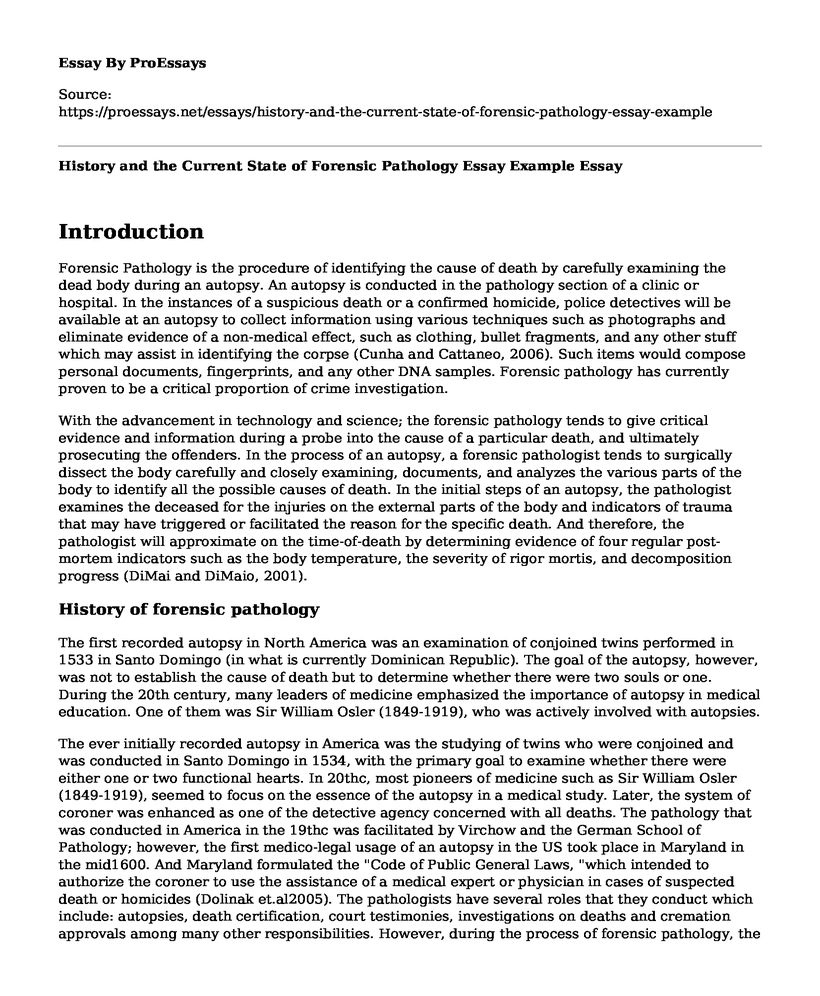Introduction
Forensic Pathology is the procedure of identifying the cause of death by carefully examining the dead body during an autopsy. An autopsy is conducted in the pathology section of a clinic or hospital. In the instances of a suspicious death or a confirmed homicide, police detectives will be available at an autopsy to collect information using various techniques such as photographs and eliminate evidence of a non-medical effect, such as clothing, bullet fragments, and any other stuff which may assist in identifying the corpse (Cunha and Cattaneo, 2006). Such items would compose personal documents, fingerprints, and any other DNA samples. Forensic pathology has currently proven to be a critical proportion of crime investigation.
With the advancement in technology and science; the forensic pathology tends to give critical evidence and information during a probe into the cause of a particular death, and ultimately prosecuting the offenders. In the process of an autopsy, a forensic pathologist tends to surgically dissect the body carefully and closely examining, documents, and analyzes the various parts of the body to identify all the possible causes of death. In the initial steps of an autopsy, the pathologist examines the deceased for the injuries on the external parts of the body and indicators of trauma that may have triggered or facilitated the reason for the specific death. And therefore, the pathologist will approximate on the time-of-death by determining evidence of four regular post-mortem indicators such as the body temperature, the severity of rigor mortis, and decomposition progress (DiMai and DiMaio, 2001).
History of forensic pathology
The first recorded autopsy in North America was an examination of conjoined twins performed in 1533 in Santo Domingo (in what is currently Dominican Republic). The goal of the autopsy, however, was not to establish the cause of death but to determine whether there were two souls or one. During the 20th century, many leaders of medicine emphasized the importance of autopsy in medical education. One of them was Sir William Osler (1849-1919), who was actively involved with autopsies.
The ever initially recorded autopsy in America was the studying of twins who were conjoined and was conducted in Santo Domingo in 1534, with the primary goal to examine whether there were either one or two functional hearts. In 20thc, most pioneers of medicine such as Sir William Osler (1849-1919), seemed to focus on the essence of the autopsy in a medical study. Later, the system of coroner was enhanced as one of the detective agency concerned with all deaths. The pathology that was conducted in America in the 19thc was facilitated by Virchow and the German School of Pathology; however, the first medico-legal usage of an autopsy in the US took place in Maryland in the mid1600. And Maryland formulated the "Code of Public General Laws, "which intended to authorize the coroner to use the assistance of a medical expert or physician in cases of suspected death or homicides (Dolinak et.al2005). The pathologists have several roles that they conduct which include: autopsies, death certification, court testimonies, investigations on deaths and cremation approvals among many other responsibilities. However, during the process of forensic pathology, the expert tends to come up with various case and conclusions such as natural deaths, sharp or blunt force injuries, Toxicology, and poisonings, drowning, etc.
The current state of the science, including its present-day practical uses
Due to constant advancement in technology and science, the forensic practice has been made relatively easy .the technology of Magnetic Fingerprinting and Automated Fingerprint Identification (AFIS) has enabled the detectives to promptly link, and com[pare the figure prints at the scene of a crime with the application of extensive virtual database. Besides, the no-touching wading and the magnetic fingerprint dust helps to avoid contamination of the collected evidence and also during the process of gathering. Currently, more survey focused on the medicolegal death investigative system in trying to find out how specific medical procedures can be used to affect the unwanted death of an individual.
Conclusion
In conclusion, forensic pathology is one of the areas of forensic science that have significantly assisted in investigations pertaining to various criminals activities that generally leads to the death of an individual. The science uses various forms of technologies such as the figure print and DNA to assist in examining the dead body with the aim of finding the perpetrators. I feel the forensic science is still evolving and may in the near five to ten years more advancement will be discovered to make the forensic practice even more effective with only a single strain of evidence.
References
Cunha, E., & Cattaneo, C. (2006). Forensic anthropology and forensic pathology. In Forensic anthropology and medicine(pp. 39-53). Humana Press. https://link.springer.com/chapter/10.1007/978-1-59745-099-7_3
DiMaio, V. J., & DiMaio, D. (2001). Forensic pathology. CRC press. https://link.springer.com/chapter/10.1007/978-1-59745-099-7_3
Dolinak, D., Matshes, E., & Lew, E. O. (2005). Forensic pathology: principles and practice. Elsevier. https://www.amazon.com/Forensic-Pathology-Principles-David-Dolinak/.../01221995.
Cite this page
History and the Current State of Forensic Pathology Essay Example. (2022, Dec 10). Retrieved from https://proessays.net/essays/history-and-the-current-state-of-forensic-pathology-essay-example
If you are the original author of this essay and no longer wish to have it published on the ProEssays website, please click below to request its removal:
- Characteristics of the Crime Scene
- Types of Threats Posed to the United States - Case Study Example
- Essay Sample on Cyber Crimes by Cambridge Analytica
- Programs of Assisting Victims of Crime Essay Example
- Research Paper on Interrogation & Interviewing Techniques for Criminal Case Investigation
- Essay Example on Patients' Rights in Medical Care: A Must-Follow
- Paper Example on Crime Scene Investigation Training: 1 Week Essential Program







